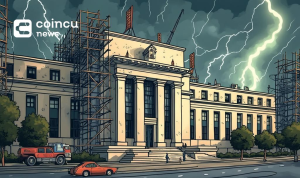$118921.528
At CoinCu News, we give both basic and in-depth articles on the latest news in the cryptocurrency and blockchain sectors.
Mayowa is a seasoned freelance writer specializing in creating compelling, high-converting content across diverse industries.
With extensive experience working with major news outlets, personal blogs, and private clients, he brings a deep understanding of audience engagement and storytelling. His expertise spans SEO optimization, persuasive copywriting, and niche versatility, ensuring content that resonates and delivers results.
Armed with a strong command of the English language and a keen eye for detail, he crafts content that is both impactful and strategically tailored to meet client goals.
News
Federal Reserve Faces Pressure Over Rate Cuts Amid Building Renovation
Federal Reserve under pressure for rate cuts amid $2.5 billion renovation controversy.
Jul
U.S. House Prepares for Crypto Week, Key Bills Advance
U.S. House sets stage for Crypto Week, enacting pivotal digital asset legislation by July 20.
Jul
U.S. Imposes 30% Tariffs on European Union Exports
U.S. President Trump announces 30% tariffs on EU exports, sparking significant economic reactions.
Jul
Pump.fun Acquires Kolscan; Token Sale Generates $500 Million
Pump.fun acquires Kolscan and raises $500 million from a token sale, impacting crypto markets.
Jul
Alleged Smear Campaign Involving Binance, Coinbase Revealed
Allegations surface of Coinbase's potential smear campaign against Binance and links to Trump. Key details
Jul
Real-World Asset Tokenization Surpasses $129 Billion TVL
RWA tokenization reaches new heights, with TVL surpassing $129 billion, led by BlackRock, Ethena, and
Jul
Trump Imposes 30% Tariff on EU and Mexico Goods
Trump announces a 30% tariff on EU and Mexico imports, impacting global trade and markets.
Jul
Trump’s 2025 Tariff Strategy: Implications for Global Trade and Cryptocurrency Markets
President Trump imposes new tariffs on 24 countries and the EU, potentially reshaping global trade
Jul
Kenya Launches National Digital Token on Solana Blockchain
Kenya unveils KenyaNDT on Solana, aligning with national digital strategy; monthly trading exceeds $500M.
Jul
[tptn_list how_old="7" limit="5" title_length="0" heading="0" show_date="0" ]
[tptn_list how_old="30" limit="5" title_length="0" heading="0" show_date="0" ]






















